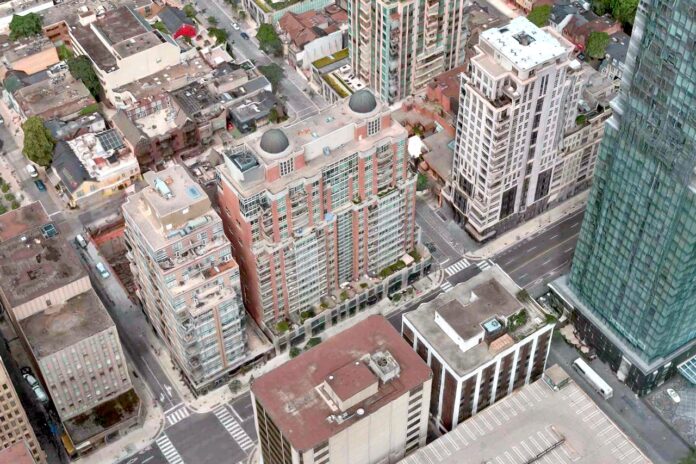The city of Toronto has a plan to achieve net zero carbon emissions by 2040 – an ambitious and challenging goal. Today the city took a step forward by announcing the buildings participating in the Deep Retrofit Challenge (DRC). The competitive program is expected to allocate up to $5 million for these buildings to undertake massive upgrades to reduce greenhouse gas (GHG) emissions.
Participating buildings will receive up to a $500,000 grant from Natural Resources Canada through the Green Infrastructure – Energy Efficient Buildings Program. The maximum is $200 per square foot of gross floor area or 25% of the total project cost, whichever is less. The funds are intended to help with the planning and construction costs, to massively reduce the CO2 footprint of the buildings and at the same time to save costs in the long term.
61 Yorkville Avenue double dome is among Toronto buildings participating in the Deep Retrofit Challenge, image retrieved from Apple Maps
The following buildings were selected as the first to benefit from the program:
- 350 Bay St. (Dream Office REIT)
- 723 Bloor St. W. (Unlimited Dream)
- 88 College St. (The Governing Body of the University of Toronto)
- 1-15 Field Sparroway and 2-10 Tree Sparroway (Toronto Community Housing)
- 633 Northcliffe Blvd. (Northcliffe Inc.)
- 177 St. George St. (Unlimited Dream)
- 145 Woodward Ave. (145 Woodward Ave. Inc.)
- 61 Yorkville Ave. (Minto Apartment limited partnership)
Greenhouse gas emissions by building type in 2020, image from City of Toronto website
Application intake began on August 26, 2022, with the program expecting applicants to be able to demonstrate cost-effective avenues for significant reductions that other sites could replicate. The upgrades are called “deep” because they must affect the entire building and all integrated components. These deep retrofits also support the city’s Net Zero Existing Buildings strategy.
The above eight participants must now complete a Participant Agreement in order to remain in the program. They remain eligible only if they can provide a final design that demonstrates they meet the requirements of the DRC program.
Toronto’s GHG emissions by source in 2020, image from City of Toronto website
Challenge participants are currently finalizing these designs, including workshops and modelling. Buildings must aim to reduce greenhouse gas emissions and overall energy use intensity by at least 50%, with a payback period of no more than 20 years.
Annual community-wide net costs and savings for net-zero plans for 2040 and 2050, with net savings when blue line is below 0, image from City of Toronto website
The challenge is part of TransformTO’s Net Zero Climate Action Strategy. Ambitious targets include halving all of Toronto’s GHG emissions by 2030 before reaching net-zero emissions by 2040. With buildings consuming 50% of the city’s emissions, massive upgrades and changes to developments are essential to have any chance of meeting these goals.
Building emissions as part of the Net Zero Plan by 2040, image from City of Toronto website
These upgrades must be completed by January 31, 2025. This is followed by case studies of the designs, savings and lessons learned for future work on other buildings.
Toronto’s GHG emissions by source in 2020, image from City of Toronto website
Visit the City’s Deep Retrofit Challenge website for more information. Toronto residents can also request to be added to the mailing list by contacting [email protected].
UrbanToronto will continue to monitor the progress of this program. If you wish, you can join the conversation by leaving a comment in the space provided on this page.
* * *
UrbanToronto has a research service, UrbanToronto Pro, that provides comprehensive data on metro Toronto development projects from concept to completion. We also offer instant reports, downloadable snapshots based on location, and a daily subscription newsletter, New Development Insider, that follows projects from the first application.














